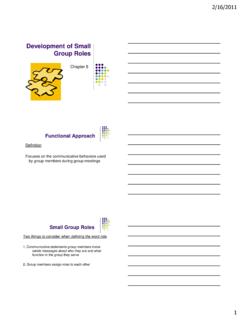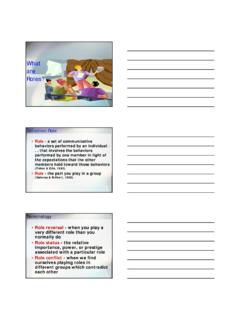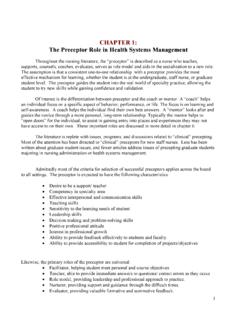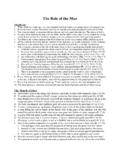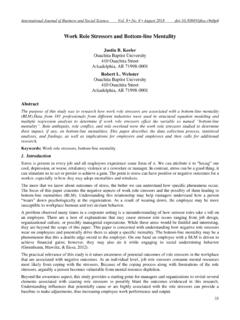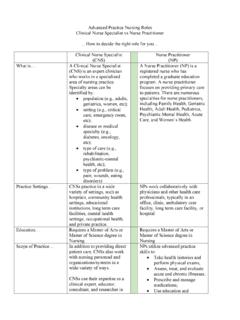Transcription of Role-Based Access Control (RBAC) - Syracuse University
1 CIS/CSE 785: Computer Security ( Syracuse University )RBAC: 1 Role-Based Access Control (RBAC)1 MotivationWith many capabilities and privileges in a system, it is difficult to manage them, suchas assigning privilegesto users, changing assignments, keeping track of the assignments for all users, ensuring that the assignmentsare not causing security problems, etc. These tasks are particular difficult in a dynamic environment, whereusers privileges can change quite frequently. Role-Based Access Control (RBAC) can ease the RBAC: Role based Access Control Traditional Access Control : Users/groups and Access rights.
2 Elements of RBAC: Users, roles , Access Rights RBAC concept: With Role-Based Access Control , Access decisions are based on the roles that individual users haveas part of an organization. Users take on assigned roles (such as doctor, nurse, teller, manager).The process of defining roles should be based on a thorough analysis of how an organizationoperates and should include input from a wide spectrum of users in an organization. Access rights are grouped by role name, and the use of resources is restricted to individualsauthorized to assume the associated role.
3 For example, within a hospital system the role ofdoctor can include operations to perform diagnosis, prescribe medication, and order laboratorytests; and the role of researcher can be limited to gathering anonymous clinical information forstudies. The use of roles to Control Access can be an effective means for developing and enforcingenterprise-specific security policies, and for streamlining the security management process. roles : Example: Doctor, nurse, teller, manager. Role hierarchies: Role hierarchies are a natural way of organizing roles to reflect authority, responsibility, andcompetency.
4 Match the natural structure of an enterprise. A role hierarchy defines roles that have unique attributes and that may contain other roles . One role may implicitly include the operations that are associated with another role. Example: in the healthcare situation, a role Specialist could contain the roles ofDoctorand Intern. This means that members of the role Specialist are implicitly associated withthe operations associated with the roles Doctor and Intern without the administrator havingto explicitly list the Doctor and Intern operations.
5 Moreover, the roles Cardiologist andRheumatologist could each contain the Specialist role. Role-Role relations: Mutually exclusive: the same user is not allowed to take on both 23, 2008 CIS/CSE 785: Computer Security ( Syracuse University )RBAC: 2 Inheritance: one role inherits permissions assigned to a different role. These relations can be used to enforce security policies that include separation of duties anddelegation of authority. User-Role relationship: Assigning roles to users. Access rights Role-Permission relationships: Access rights are grouped by role name.
6 For example, the role of doctor can include operations to perform diagnosis, prescribe medica-tion, and order laboratory tests; the role of researcher can be limited to gathering anonymousclinical information for studies. NIST Studies: Permissions assigned to roles tend to change relatively slowly compared to changes in usermembership of roles . Assignment of users to roles will typically require less technical skill than assignment ofpermissions to roles . Conclusion: have a predefined role-permission relationship.
7 For example, NIST is definingroles and operations suitable for the IRS environment, Veterans Administration, etc. Theprocess of defining roles should be based on thorough analysis of howan organizationoperates. Rules for the association of operations with roles . In addition to the association of Access right with roles , RBAC can also set extra rules to regulatethe use of those Access rights. RBAC provides administrators with the capability to regulate who can perform what actions,when, from where, in what order, and in some cases under what relational circumstances.
8 Example 1: Organizations can establish the rules for the association of operations with roles . For example, a healthcare provider may decide that the role of clinician must be constrainedto post only the results of certain tests but not to distribute them where routingand humanerrors could violate a patient s right to privacy. Example 2: A teller and an accounting supervisor in a bank. Teller: read/write Access to records. Supervisor: perform correction (also need read/write Access ). Rules 1: Supervisor cannot initiate deposits or withdrawals, but can only perform correc-tions after the fact.
9 Rule 2: Teller can only initiate deposits or withdrawals, but cannot performcorrectionsonce the transaction has been completed. Example 3: Operations can also be specified in a manner that can be used in the demonstrationand enforcement of laws or regulations. For example, a pharmacist can be provided with operations to dispense, but not to prescribe,medication. Example 4: Several employees may act in a manager 23, 2008 CIS/CSE 785: Computer Security ( Syracuse University )RBAC: 3 Rule: the role can be granted to only one employee at a time.
10 Supporting three well-known security principles Least privilege: A user can be given no more privilege than is necessary to perform the job. This concept ofleast privilege requires identifying the user s job functions, determining the minimum set ofprivileges required to perform that function, and restricting the user to adomain with thoseprivileges and nothing more. Separation of duties: mutually exclusive For example, requiring an accounting clerk and account manager to participate in issuing acheck.
